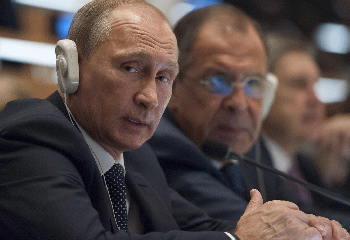
Russian President Attends 70th General Assembly Debate
(Image by United Nations Photo from flickr) Details DMCA
Back in December, Russia sent the U.S. and NATO two draft treaty documents spelling out its demands for security guarantees related to NATO's posture in Eastern Europe. These demands came in a climate of tension fueled by both a Russian military buildup bordering Ukraine and U.S. and NATO hysteria over what they deemed an imminent Russian military incursion into Ukraine.
The written replies that arrived on Jan. 22 failed as expected to address any of Russia's concerns, including the red line of continued NATO expansion. Rather, the U.S. and NATO listed alternative pathways to diplomatic engagement, including arms control and limits on military exercises, and they now couch the ongoing crisis as a choice between accepting the diplomatic offramp they dictated, or war.
Russia, however, is far too sophisticated to allow itself to be boxed into such a corner. In the weeks and months ahead, Russia will be the one dictating the outcome of this crisis which will be a resounding Russian victory.
The Russian buildup in its western and southern military districts, as well as in Belarus has two purposes. The secondary goal is to demonstrate Russia's ability, at a time and place of its choosing, to project sufficient military power into Ukraine to overwhelming defeat the Ukrainian armed forces and bring down its government.
To be clear, Russia has threatened neither of these outcomes. It maintains that the military buildup is simply an exercise designed to ensure it can respond to NATO's aggressive expansion of forces along its western flank. It traces the confrontation to NATO's "original sin" of expansion.
Historical fact supports the Russian interpretation: The Russian mantra of "not one inch eastward" is derived from an oral promise made by former Secretary of State James Baker to Soviet President Mikhail Gorbachev at the time of German reunification. But Russia's goal is not to score debating points, but rather to reverse NATO policy and posturing it deems harmful to its national security.
To this end, the primary purpose of Russia's military buildup is to expose the political, military, and economic impotence of the U.S./NATO partnership by a range of crises independent of any military incursion into Ukraine for which the U.S. and NATO have no viable response other than to give in to most, if not all of Russia's demands for security guarantees.
Crying 'Wolf'
The stage for the current crisis was set back in the spring of 2021, when Russia mobilized around 100,000 troops along the lines seen today. The U.S. and NATO immediately began a rhetoric-based war of perception management, using mainstream media and think tanks to paint a picture of Russian malfeasance and Western resolve.
A face-to-face meeting between Russian President Vladimir Putin and U.S. President Joe Biden resulted, and Russia eventually drew down its forces but not before making several salient points: It demanded that the West hold Ukraine's feet to the fire regarding fulfillment of its obligations under the 2015 Minsk agreement. And after a "freedom of navigation" exercise which brought a British destroyer into contested waters off Crimea, it declared red lines Russia was prepared to defend, with force if necessary.
Russia took away two lessons from this. First, that neither the U.S. nor NATO had a viable military response. Russian military superiority in any future conflict with Ukraine was all but assured. Second, that the only response either the U.S. or NATO could come up with would center on economic sanctions. This stress test exposed several critical weaknesses Russia could exploit.
Armed with these important insights, Russia waited until last fall to repeat the stress test, again mobilizing more than 100,000 troops near Ukraine and deploying tens of thousands of elite shock troops the First Guards Tank Army into Belarus. Again, Russia issued no threats, stating repeatedly that it was simply conducting routine military exercises.
The U.S. and NATO, in contrast, immediately cast the Russian buildup as proof positive of its intent to invade Ukraine. In drawing this conclusion despite Russian denials and Ukraine's rejection of the inevitability of such an outcome both the U.S. and NATO effectively founded their position on the principle of the inviolability of NATO's "open-door" policy which says that any nation qualified for NATO membership should have the opportunity to join.
For its part, Russia noted that NATO's eastward expansion has created an unacceptable national security risk. It claims a right to exert a sphere of influence around its borders, implying that any accession to NATO by the former Soviet Republics of Ukraine or Georgia is viewed as an existential threat that would require a "military-technical" response. Russia said as much in the two draft treaties it submitted in December. Furthermore, Russia demanded that both NATO and the U.S. respond in writing.
(Note: You can view every article as one long page if you sign up as an Advocate Member, or higher).





